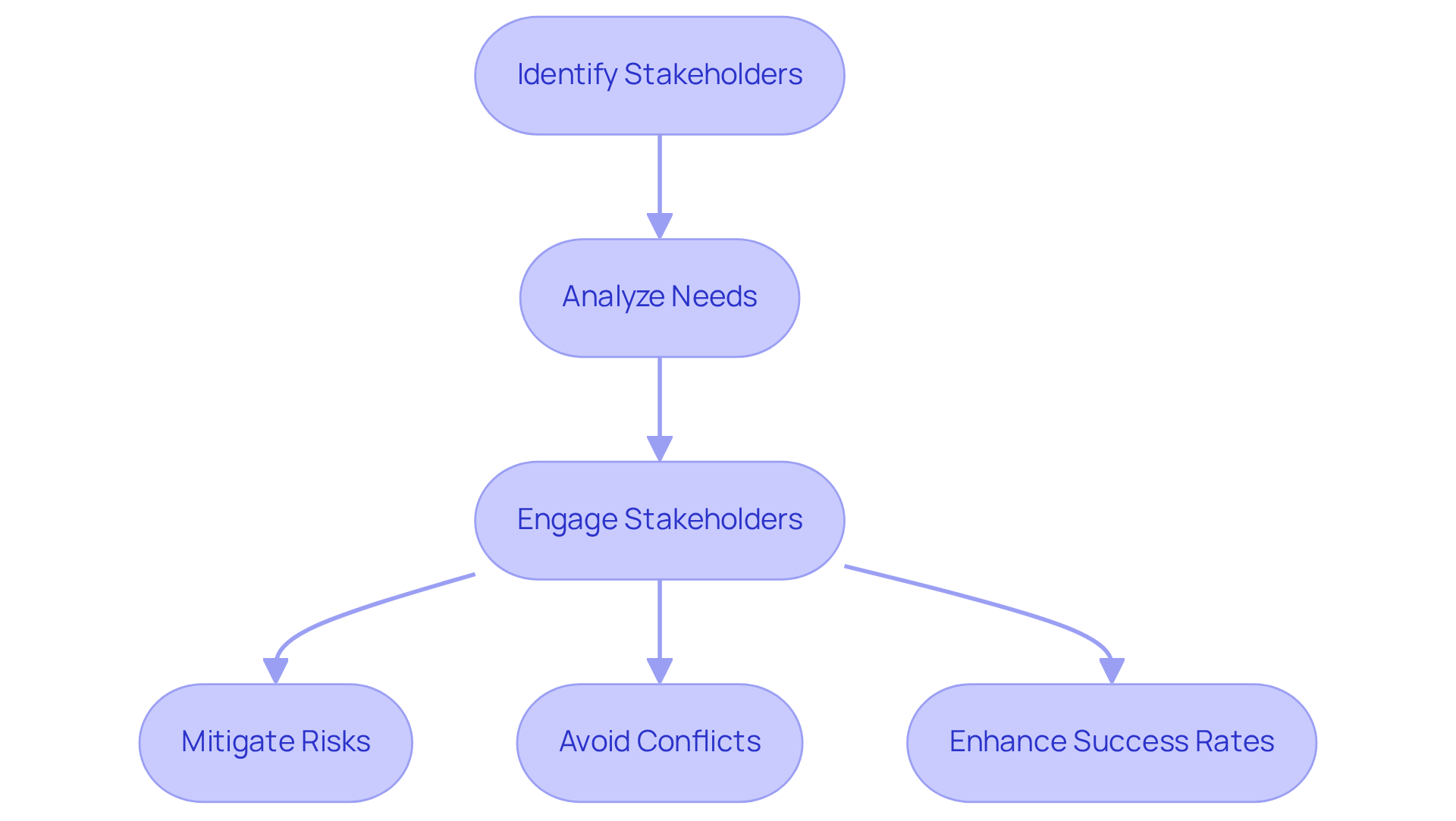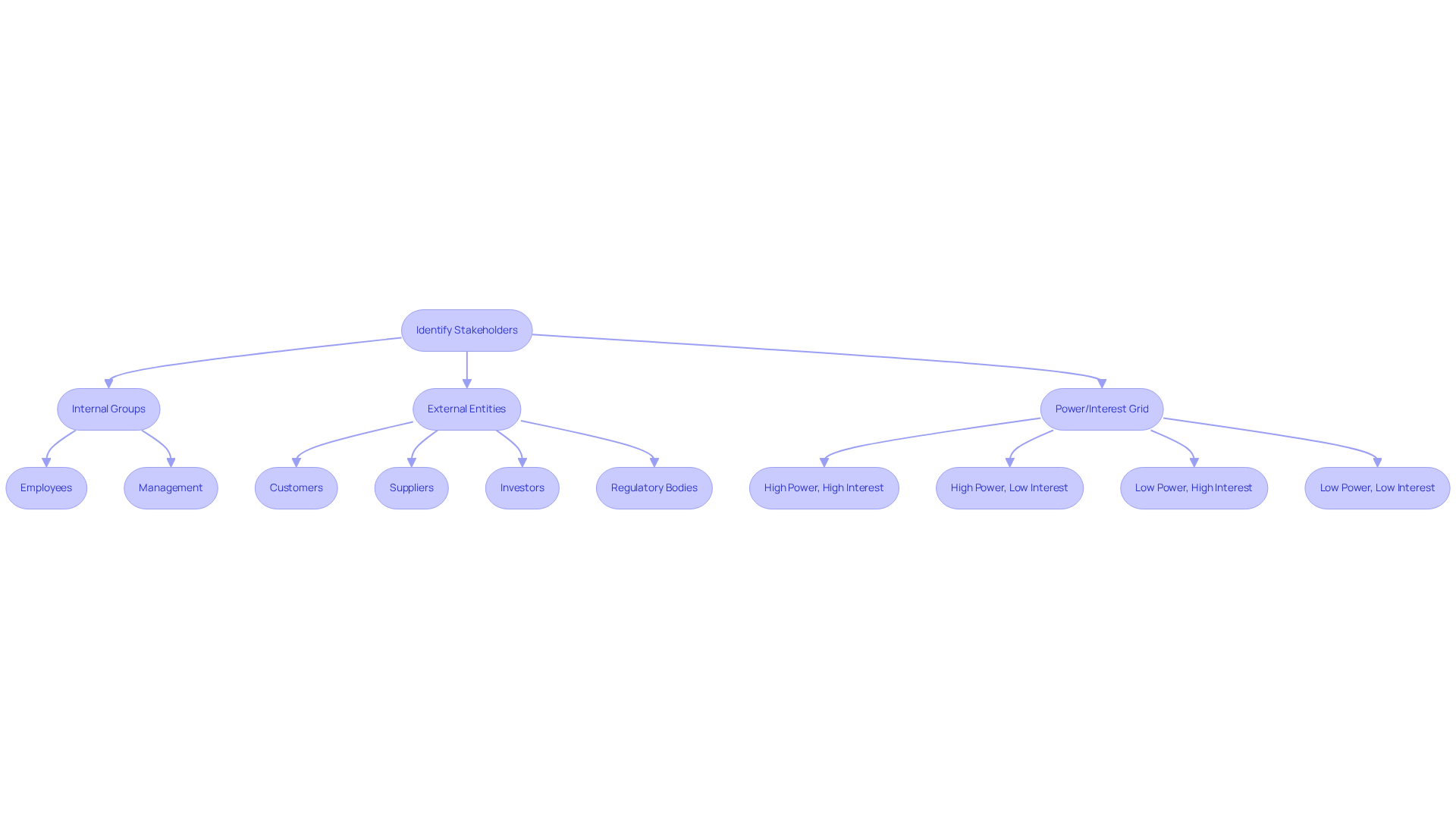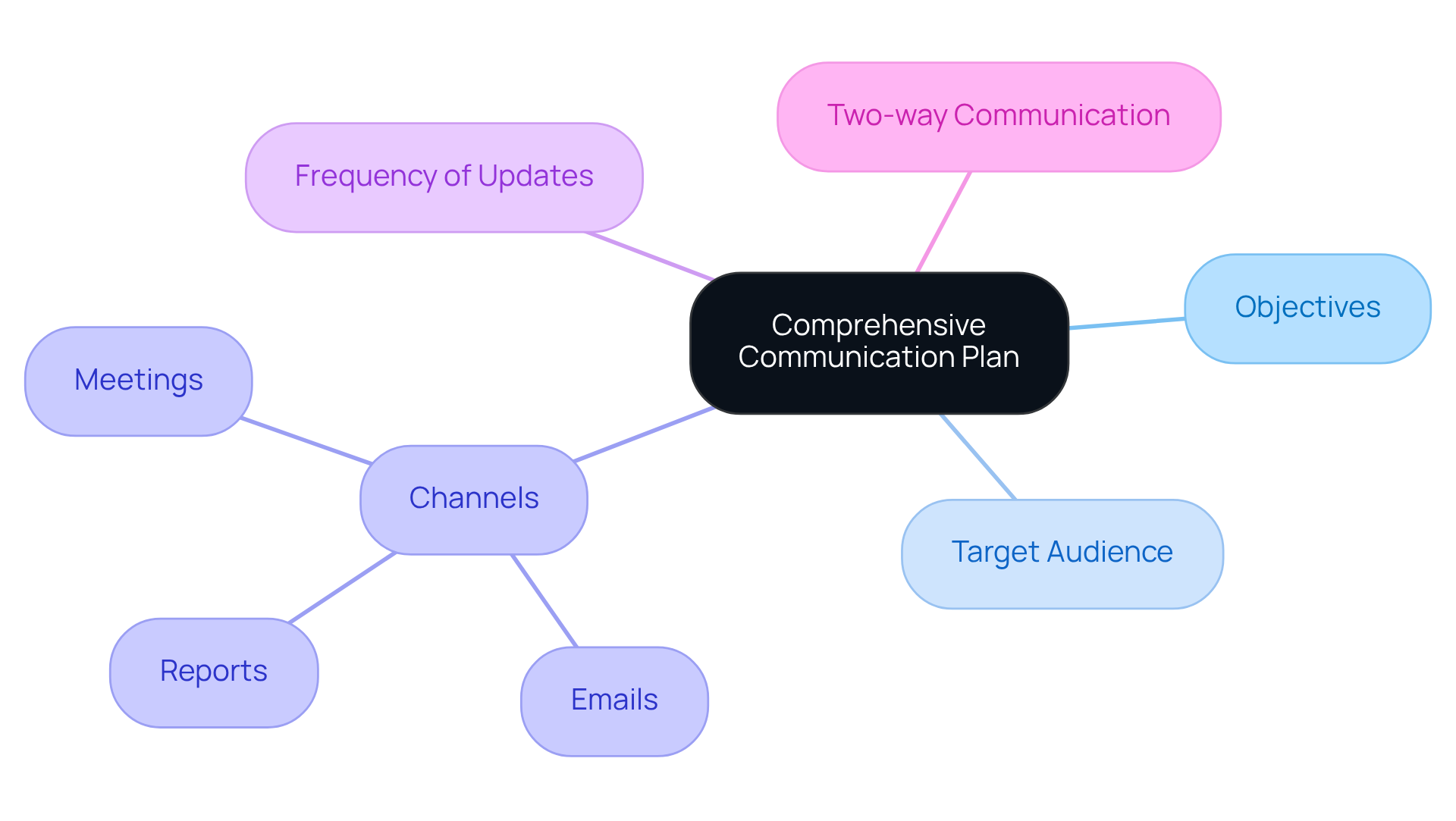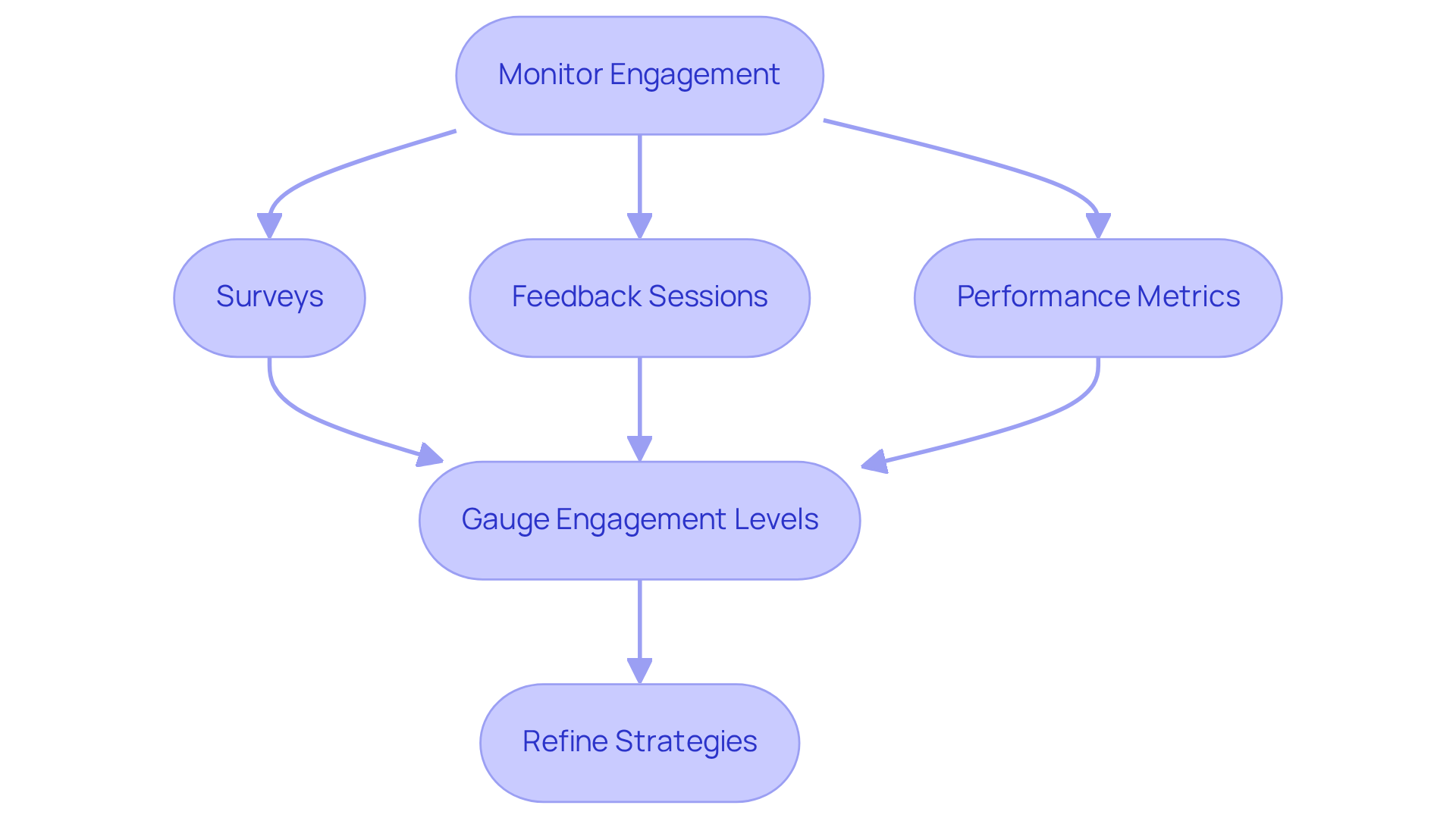Overview
The article delineates four pivotal practices for effective executive stakeholder management:
- Identifying and categorizing stakeholders
- Establishing a comprehensive communication plan
- Monitoring engagement
- Adapting strategies
These practices are indispensable as they cultivate robust relationships, guarantee clear communication, and facilitate responsive adjustments based on stakeholder feedback. Ultimately, they enhance project success rates and foster organizational alignment, underscoring the necessity of implementing these strategies for optimal outcomes.
Introduction
Effective executive stakeholder management transcends mere buzzword status; it stands as a critical practice capable of determining project success or failure across diverse industries. By comprehensively understanding and engaging stakeholders—those individuals or groups affected by or interested in an initiative—organizations can significantly enhance communication, align expectations, and ultimately achieve their business objectives.
Many leaders, however, grapple with the complexities of managing these relationships, prompting the essential question: what key practices can transform stakeholder engagement from a challenge into a strategic advantage?
This article explores four essential practices that not only cultivate robust stakeholder relationships but also pave the way for sustainable organizational growth.
Define Stakeholder Management and Its Importance
[Executive stakeholder management](https://zoetalentsolutions.com/stakeholder-engagement-effectiveness) represents a methodical strategy for recognizing, examining, and engaging individuals or groups with an interest in or affected by an initiative or entity. This process is vital for effective executive stakeholder management as it fosters robust relationships, clarifies expectations, and enhances communication. By understanding stakeholders' needs and concerns, organizations can effectively implement executive stakeholder management to mitigate risks, avoid conflicts, and ensure alignment with broader business objectives. This proactive strategy not only enhances success rates but also contributes to long-term organizational sustainability and growth through effective executive stakeholder management.
For instance, during a retail restructuring, executive stakeholder management that engages suppliers, employees, and customers is essential to address their needs throughout the transition. Such involvement can lead to smoother operations and improved outcomes for all parties involved. Statistics reveal that projects with efficient participant management succeed 83% of the time, compared to only 32% for those lacking emphasis on participant involvement. This underscores the essential role of in achieving organizational objectives and improving overall performance.

Identify and Categorize Stakeholders
Successful management of involved parties, through effective executive stakeholder management, begins with the identification of all relevant participants, encompassing both internal groups—such as employees and management—and external entities like customers, suppliers, investors, and regulatory bodies. Once these participants are recognized, they should be classified according to their impact and interest in the initiative.
A widely utilized technique for this classification is the Power/Interest Grid, which ranks participants by mapping their level of influence against their interest in the project. For example, individuals categorized as high power and high interest necessitate close management and regular updates to ensure their needs are met. Conversely, individuals with minimal influence and little interest may require less frequent communication, allowing organizations to allocate resources more effectively.
This strategic classification not only streamlines interaction efforts but also supports effective executive stakeholder management, empowering organizations to to meet the specific needs and expectations of each group of stakeholders. By understanding these dynamics, companies can enhance outcomes through effective executive stakeholder management and foster stronger relationships.
Moreover, the client involvement process should commence with a comprehensive business assessment to align key participants and gain a deeper understanding of the business context beyond mere figures. This initial step facilitates the identification of underlying business issues and the formulation of a strategic plan to address weaknesses while bolstering strengths. Continuous business performance assessment and relationship development through real-time analytics further improve the management of involved parties, ensuring that organizations can adapt their strategies as the dynamics of these parties evolve throughout the lifecycle. It is essential to remember that participant dynamics can shift during the lifecycle of the endeavor, necessitating ongoing evaluation and adjustment of involvement strategies.

Establish a Comprehensive Communication Plan
A comprehensive communication strategy is essential for effectively engaging interested parties throughout a project. This plan must clearly outline the , identify the target audience, specify the channels to be utilized—such as emails, meetings, and reports—and establish the frequency of updates.
For instance, consider a hospitality company undergoing restructuring; it could implement regular updates for employees and interested parties. This ensures that they remain informed about changes while also providing a platform for feedback.
Incorporating mechanisms for two-way communication is essential; it enables participants to express their concerns and suggestions, thereby enhancing transparency and fostering a sense of ownership. This collaborative method not only enhances relationships but also significantly improves project results, as participants feel more invested in the process.

Monitor Engagement and Adapt Strategies
Tracking is essential for evaluating the effectiveness of communication tactics and overall participant satisfaction. This can be achieved through various methods, including:
- Surveys
- Feedback sessions
- Performance metrics
For instance, organizations can utilize satisfaction surveys to gauge engagement levels and refine their communication strategies based on the insights gathered. If feedback indicates that stakeholders are concerned about the pace of change, increasing the frequency of updates or providing additional resources can effectively address these concerns. Such responsiveness not only strengthens relationships but also significantly boosts project success rates.
Research shows that involving key employees in collaboration initiatives can make transformations four times more likely to succeed, underscoring the necessity of adjusting strategies based on input from engaged parties. Furthermore, organizations that actively solicit feedback experience a 20% increase in participation rates, illustrating the tangible benefits of a proactive approach to stakeholder management.
By integrating real-time business analytics via our client dashboard and committing to testing hypotheses, companies can continuously monitor the effectiveness of their outreach strategies, allowing for timely adjustments that enhance participant satisfaction. However, it is crucial to recognize the limitations of statistical analysis in evaluating the impact on involved parties, as noted in various studies. By synthesizing these insights, organizations can more effectively navigate the complexities of stakeholder engagement.

Conclusion
Effective executive stakeholder management is crucial for achieving organizational success and maintaining robust relationships with all parties involved. By systematically identifying, categorizing, and engaging stakeholders, organizations can not only meet their needs but also align their goals with broader business objectives. This proactive approach fosters communication, mitigates risks, and enhances overall project outcomes, ultimately contributing to long-term sustainability and growth.
The article highlights four key practices essential for successful stakeholder management:
- Defining stakeholder management and its importance
- Identifying and categorizing stakeholders
- Establishing a comprehensive communication plan
- Monitoring engagement while adapting strategies
Each of these practices underscores the necessity of understanding stakeholder dynamics and the impact of effective communication on project success. By employing techniques such as the Power/Interest Grid and implementing real-time feedback mechanisms, organizations can tailor their strategies to ensure that all voices are heard and valued.
In conclusion, prioritizing executive stakeholder management not only enhances project success rates but also builds a foundation for enduring partnerships. Organizations are encouraged to adopt these best practices, actively engage with stakeholders, and remain flexible in their approach to communication and feedback. By doing so, they can navigate the complexities of stakeholder relationships and drive meaningful results that benefit all parties involved.
Frequently Asked Questions
What is stakeholder management?
Stakeholder management is a methodical strategy for recognizing, examining, and engaging individuals or groups that have an interest in or are affected by an initiative or entity.
Why is stakeholder management important?
It is important because it fosters robust relationships, clarifies expectations, and enhances communication, which helps organizations mitigate risks, avoid conflicts, and ensure alignment with broader business objectives.
How does stakeholder management contribute to organizational success?
By understanding stakeholders' needs and concerns, organizations can implement strategies that enhance success rates and contribute to long-term sustainability and growth.
Can you provide an example of stakeholder management in action?
During a retail restructuring, engaging suppliers, employees, and customers is essential to address their needs throughout the transition, leading to smoother operations and improved outcomes.
What are the success rates of projects with effective stakeholder management?
Projects with efficient stakeholder management succeed 83% of the time, compared to only 32% for those that lack emphasis on participant involvement.




